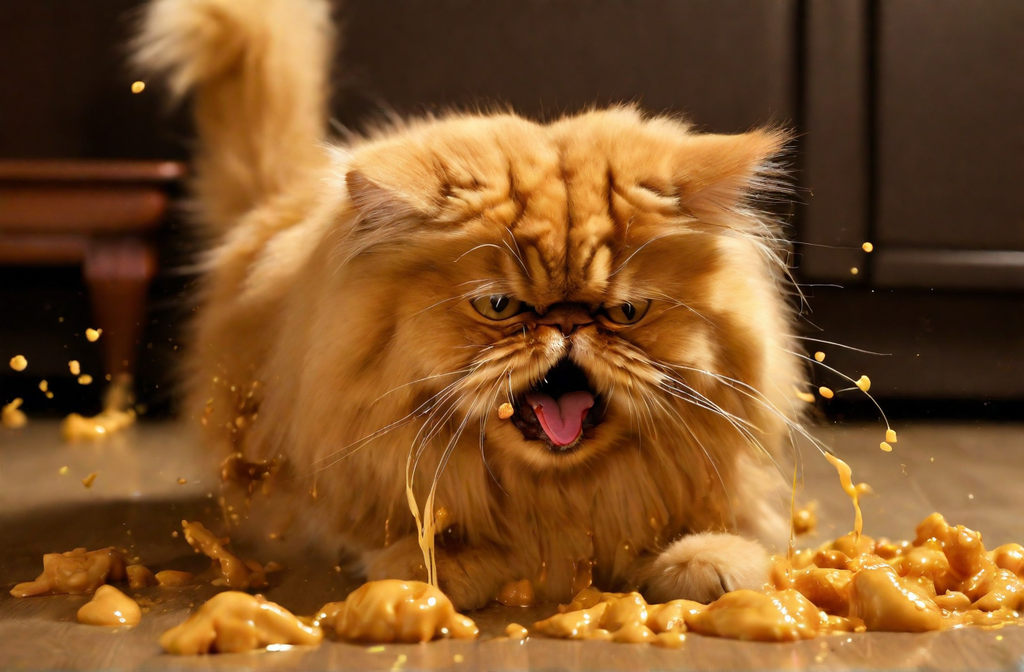My cat, Mittens, might be the cutest little fuzzball on the planet, but sometimes her breath could knock a buzzard off a fence post! Don’t get me wrong, I love her to pieces, but let’s face it, bad breath isn’t exactly a sign of a healthy kitty.
That’s when I learned all about the importance of feline dental hygiene. Just like our own teeth, cats’ teeth need regular care to stay healthy and strong. Brushing, special dental treats, and even scheduled vet checkups can all play a part in keeping Mittens’ mouth happy and her breath fresh.
Now, I know what you’re thinking: “Brush my cat’s teeth? Are you crazy?” Well, hold on a meow-ment! Brushing might sound scary, but with a little patience and the right tools, it can actually become a bonding experience for you and your furry friend.
In this purr-fect guide, we’ll explore everything you need to know about keeping your cat’s teeth clean and healthy. We’ll cover the basics of feline dental care, from the tools you’ll need to the best brushing techniques. Plus, we’ll answer some frequently asked questions to help you feel confident taking care of your cat’s pearly whites.

Why is Dental Care Important for Cats?
You might be surprised to learn that dental problems are actually very common in cats. Just like us, cats can build up plaque and tartar on their teeth. This can lead to a number of issues, including:
Bad breath: This is probably the most obvious sign of dental problems in cats. But trust me, it’s not the only one.
Gum disease: This is a painful condition that can cause your cat to lose teeth.
Pain and discomfort: Dental problems can make it difficult for your cat to eat, which can lead to weight loss and other health problems.
Serious infections: In some cases, dental infections can spread to other parts of your cat’s body, which can be very dangerous.
By taking care of your cat’s teeth, you can help prevent these problems and keep your feline friend healthy and happy.
Getting Started with Feline Dental Care
Okay, so you’re convinced that dental care is important for your cat. Great! Now, let’s talk about how to get started. Here are a few things you’ll need:
Cat-friendly toothbrush: Forget about using your own toothbrush! Cats have tiny mouths, so you’ll need a soft, small toothbrush specifically designed for felines. You can find these at most pet stores.
Cat toothpaste: Human toothpaste is a no-no for cats! It contains ingredients that can be toxic to them. Look for a toothpaste made specifically for cats. These often come in flavors that cats enjoy, like chicken or fish.
Patience and positive reinforcement: Brushing your cat’s teeth might take some time and practice. Be patient and offer plenty of praise and treats throughout the process.
Brushing Your Cat’s Teeth: A Step-by-Step Guide
Now, for the fun part (well, maybe not for Mittens at first)! Here’s how to brush your cat’s teeth:
Get your cat used to the routine: Start by gently massaging your cat’s gums with your finger for a few days. This will help them get used to having something in their mouth.
Let your cat taste the toothpaste: Put a small amount of toothpaste on your finger and let your cat lick it off. This will help them get used to the flavor.
Introduce the toothbrush: Once your cat is comfortable with your finger in their mouth, you can introduce the toothbrush.
Start slow: Focus on brushing just a few teeth at a time, especially at first.
Use gentle motions: Brush in a circular motion, focusing on the gumline.
Keep it short and sweet: Aim for a brushing session of 30 seconds to 1 minute, twice a day.
Reward your cat: After each brushing session, give your cat a treat or lots of praise for being a good kitty!
Don’t Worry, Brushing Isn’t the Only Option
If the thought of brushing your cat’s teeth makes you break out in a cold sweat, don’t despair! There are other ways to help keep your cat’s teeth clean. Here are a few alternatives:
1. Water Additives
Convenience: These are water additives formulated to freshen breath and potentially reduce plaque buildup. You simply add a few drops to your cat’s water bowl.
Effectiveness: The effectiveness of water additives is somewhat debated. Some studies show a mild reduction in plaque, while others haven’t found significant benefits.
Drawbacks: Some cats may dislike the taste and refuse to drink enough water.
2. Dental Treats and Kibble
Convenience: There are a variety of dental treats and kibble specifically designed to promote dental health. They often have a textured surface that helps scrape away plaque as your cat chews.
Effectiveness: Similar to water additives, the effectiveness can vary. It might offer some plaque reduction but wouldn’t be as thorough as brushing or chews.
Drawbacks: Not all dental treats or kibble are created equal. Read the ingredients and look for those with a focus on dental health. Also, be mindful of portion control to avoid overfeeding.
3. Dental Wipes and Gels
Convenience: Dental wipes and gels can be a good option for cats who dislike brushing. You can gently wipe the gel or solution onto your cat’s teeth and gums with a fingertip.
Effectiveness: While not as effective as a full brushing, they can help remove some plaque and freshen breath.
Drawbacks: This method might be more time-consuming than other alternatives and may not be suitable for all cats who dislike having their mouths touched.
4. Raw Diets
Concept: Some cat owners believe that feeding a raw diet can help with dental health as the chewing action on raw meat and bones can naturally clean teeth.
Effectiveness: There’s limited research on the effectiveness of raw diets for feline dental health. It’s important to note that raw diets come with their own set of risks, such as bacterial contamination and nutritional deficiencies. Always consult your veterinarian before switching your cat to a raw diet.
Dental Chews
Dental chews are specially formulated treats that help remove plaque and tartar from your cat’s teeth as they chew. They come in various textures, shapes, and sizes to cater to different chewing preferences. The chewing action helps to scrape away plaque and tartar buildup, similar to how flossing works for humans.
Choosing the Right Dental Chews
Not all chews are created equal when it comes to feline dental health. Here’s what to look for:
VOHC Seal of Approval: Look for chews that carry the Veterinary Oral Health Council (VOHC) seal of approval. This means the chew has been scientifically proven to reduce plaque and tartar buildup.
Texture: Some cats prefer softer chews, while others enjoy a good crunch. Experiment with different textures to see what your cat likes best.
Size and Shape: Chews should be appropriate for your cat’s size. Smaller chews are ideal for kittens and adult cats with smaller mouths.
Ingredients: Choose chews made with natural, healthy ingredients. Avoid chews with artificial colors, flavors, or excessive sugars.
Safety: Make sure the chews are made from high-quality, digestible materials to prevent choking hazards.
Using Dental Chews Effectively
Dental chews are a great tool, but they shouldn’t be the only line of defense in your cat’s dental care routine. Here are some tips for using them effectively:
Supervision is key: Supervise your cat while they chew to ensure safety and prevent them from swallowing large chunks.
Moderate consumption: Treats are treats! Stick to the recommended serving size for your cat’s weight and age. Overconsumption can lead to weight gain and digestive issues.
Variety is key: Rotate different types of dental chews to keep your cat interested and engaged.
Dental chews are a convenient and effective way to help keep your cat’s teeth clean and healthy. However, they shouldn’t replace regular brushing entirely. Ideally, combine brushing with dental chews for the ultimate in feline dental care. Remember to consult your veterinarian if you have any questions or concerns about your cat’s dental health.
These alternatives can be helpful tools, but they shouldn’t completely replace regular dental checkups and professional cleanings performed by your veterinarian. Discuss a comprehensive dental care plan for your cat with your vet to determine the best approach based on their individual needs and your preferences.
Feline Dental Hygiene: FAQs
Now that we’ve covered the basics of feline dental hygiene, let’s address some frequently asked questions to help you feel even more confident taking care of your cat’s mouth.
FAQs
How often should I brush my cat’s teeth?
Ideally, you should brush your cat’s teeth twice a day, just like you would your own. However, even once a day is better than nothing.
What if my cat absolutely hates getting their teeth brushed?
Don’t worry, you’re not alone! Many cats dislike having their teeth brushed. If your cat fights you tooth and nail (pun intended!), don’t force it. Start with short, positive sessions and gradually increase the duration. You can also try alternative methods like dental chews or water additives.
What are the signs of dental problems in cats?
Here are some signs to watch out for:
Bad breath, Difficulty eating, Pawing at the mouth, Red swollen gums, Loose teeth, Weight loss
If you notice any of these signs, it’s important to schedule a checkup with your veterinarian.
What happens at a dental cleaning for cats?
Dental cleanings for cats are typically performed under anesthesia. During the cleaning, your veterinarian will remove plaque and tartar from your cat’s teeth and may also need to extract any loose or infected teeth.
How much does a dental cleaning for cats cost?
The cost of a dental cleaning for cats can vary depending on your location and the complexity of the procedure. However, you can expect to pay anywhere from $300 to $1,000.
Can I use baking soda or human toothpaste on my cat’s teeth?
No! Baking soda can be toxic to cats if ingested, and human toothpaste contains ingredients that can upset their stomachs. Always use toothpaste specifically formulated for cats.
Is dental care for cats really necessary?
Yes! Just like humans, cats are susceptible to dental problems that can cause them pain and discomfort. Taking care of your cat’s teeth is an important part of their overall health and well-being.
I’m worried about putting my cat under anesthesia for a dental cleaning. Are there any alternatives?
While anesthesia is generally considered the safest way to clean a cat’s teeth thoroughly, there may be some alternatives for cats with very mild dental disease. Discuss this with your veterinarian to see if it’s an option for your cat.
My cat is a senior. Is it too late to start caring for their teeth?
It’s never too late to start taking care of your cat’s teeth! Even if your cat is older, regular dental care can help prevent further problems and improve their overall health.
Do Remember
Taking care of your cat’s teeth might seem like a chore, but it’s an important part of being a responsible pet owner. By following the tips in this guide and addressing any concerns with your veterinarian, you can help ensure your feline friend has a healthy, happy mouth for years to come.






